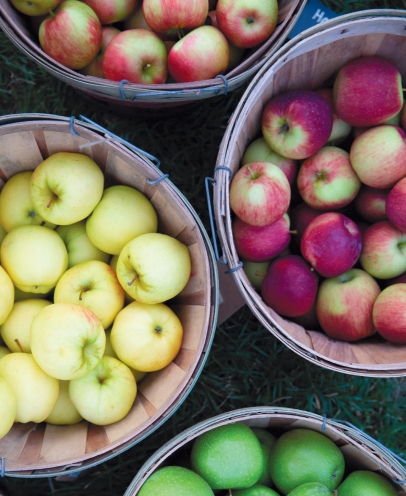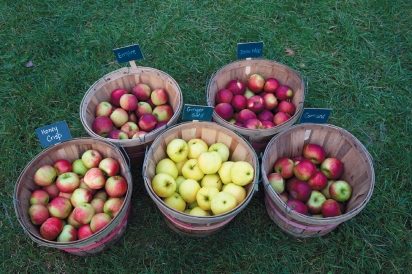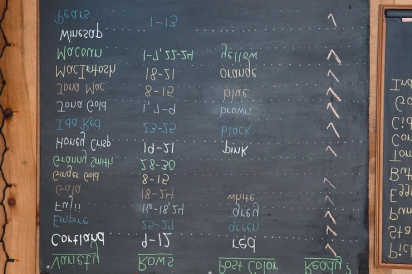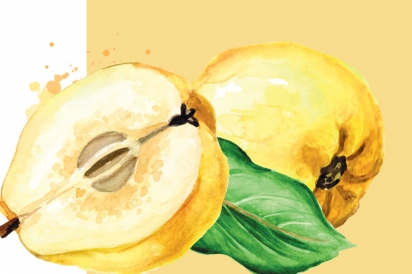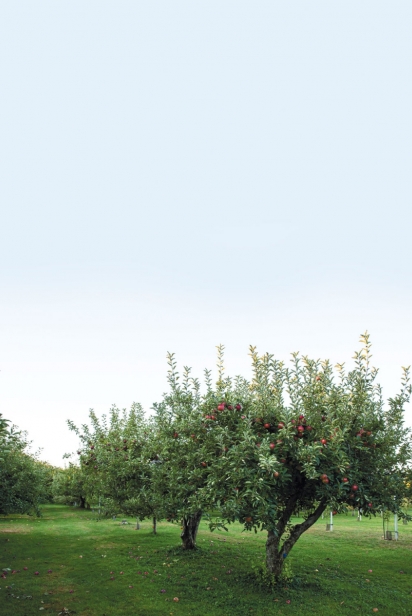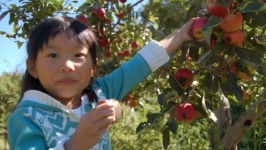Cloning the Superfruit
The Science Behind One Apple’s Rise to Stardom
If Eve had this apple at her fingertips, it’s hard to guess which quality of the Honeycrisp would have tempted her more: the satin, blemish-free skin in a whirlwind of marbled red and chartreuse or the crunchy, sweet flesh bursting with juice. Now eclipsing many traditional varieties as the fifth-most-grown, according to the U.S. Apple Association, this apple has a nascent appeal that embodies the industry’s explosion during the past four decades.
The propagation science surrounding the rise of the Honeycrisp is a prime example of what it takes to get an apple into the mainstream. Its complex DNA of 57,000 genes, which is more than any other plant or human, was bred in a Minnesota laboratory in the late 1970s for its superior mix of sweetness and acidity, but was jettisoned for lack of hardiness. Clones were later salvaged and propagated to allow the Honeycrisp to grow, ship and store well.
Local growers have different methodologies. Their propagation techniques include more trial and error and manual labor than genetics and scientific lab work, though they still must channel their inner Bill Nye the Science Guy and legendary Johnny Appleseed for their orchards to bear fruit and profits. They must learn the critical importance of grafting an apple cutting (the scion) to a rootstock, as well as continued care, like proper pruning and pest control.
And though apples, like their pear and quince cousins, are picked from late August into November in Rhode Island, growers nurture their trees through each season of the year. If the grafting isn’t successful, if a fungus or winter moth infestation takes hold, if there’s a drought (like this summer) or even if rain saturates multiple autumn weekends when customers normally flock to the orchards for picking, their entire year’s efforts are jeopardized.
Such challenges force orchardists like Greg Ostheimer of Rocky Brook Orchard in Middletown to act as chemist and entomologist, cloning wizard, mechanic, mycologist and meteorologist. Ostheimer quickly learned the importance of rootstock and cloning his successful trees when he bought the property in 1999.
“I buy trees that have been grafted and also take cuttings from our own unique unknown varieties, and graft the cutting to the rootstock,” Ostheimer says. “It’s hit or miss whether the grafting takes, so I graft more than I need. It’s a leap of faith, but I have fun doing it.”
Master gardener Bob Lund has been experimenting with twig grafting as a volunteer orchardist at Prudence Island’s Farnham Farm. Twelve years ago, Lund sliced 10 scions off the farm’s rare Farnham Delight trees before grafting them to rootstock and planting them in his garden. Once the 10 baby apple trees started growing, Lund transplanted them in the orchard, and he has watched over them ever since.
“I take care of them all the time. Mulch, prune and spray as needed. The winter moth has been the scourge, though the mite and aphid will get in, fire blight, too. The trees need to be protected,” he says.
“Three years ago, when the winter moth was so bad, we sprayed and wiped them out. Then two days later, there were millions of moths all over the place. All I could see was their webs covering the deer fencing and caterpillars everywhere. They defoliated a good portion of the island.”
Heather Faubert remembers that moth infestation, and the others that have plagued growers for decades. As an integrated pest management expert at the University of Rhode Island Cooperative Extension since 1982, Faubert monitors orchards throughout the state to see what insects, diseases and weeds are evident, and offers holistic management methods. She also offers a plant protection clinic where growers send samples of their infested crop seeking her diagnosis.
“It’s almost always the winter moth that is destroying their crop. The moths hatch early and get right into the apple and blueberry flower buds when they are vulnerable in the springtime,” she says. “Growers need to monitor for this every year because it’s so harmful, and can defoliate trees.”
As if pests and fungus weren’t enough, growers must consider a plethora of different elements to maintain their orchards—most importantly, consumer taste, though apple flavor, blight resistance and fruit maturation are also factors for such a short season, Ostheimer says.
He modified his selection to honor contemporary tastes and more than doubled the size of his orchard from 200 to 500 trees in the past 20 years. Twenty Red Delicious trees now number only three, which he says is enough to supply the demand. He is quick to concede that, among the 7,500 available apple varieties, there are many with a wider flavor spectrum than the popular Honeycrisp, equal in their usefulness and grown with less hassle. Yet he and other growers plant more of this popular newcomer in lieu of more tried and true varieties, including Empire, McIntosh and Gala siblings.
Planting more Honeycrisp trees feels like blasphemy to those orchardists who are at odds with the high-maintenance hybrid. In contrast, the first American apple, the Roxbury Russet, was brought here by European colonists, and was so hardy that it would last in underground storage for months.
“Apple culture was a huge part of 18th- and 19th-century American life. There were few national apples, but endless regional ones, each adapted to the local climate and needs,” writes author Rowan Jacobsen in his book, Apples of Uncommon Character: Heirlooms, Modern Classics and Little-Known Wonders (Bloomsbury, 2014). “Iconic apples like Rhode Island Greening and Roxbury Russet in New England; Newtown Pippin in New York and Pennsylvania … Each one had been propagated because it did something superb. Some came ripe in July, some in November. Some held their shape in pies. Some started off hard and sour, but sweetened outrageously after a few months in a root cellar.”
Apple inimitability remains largely unchanged, but genetic experimentation has exploded. In every apple seed, the genetic deck is reshuffled, writes Jacobsen, and many traits that were invisible in the parent might show up in the child, or vice versa. So that’s why rootstocks are used, to clone the traits most desired in the specific variety of apple, and to keep its traits pure. Starting the growing process from seed is a genetic crapshoot.
“The apple DNA is so complex. There are five seeds for each apple, and as many as 500 apples per tree. So, if you were to plant all 2,500 apple seeds, chances are you’d get 2,500 crabapple trees. Just like the chance is low of parents having a child that looks exactly like them,” Ostheimer says. “We have 10 trees we still can’t identify. Some may be one-of-a-kind, and a few are so good I might send them out for DNA testing.”
There are so many new varieties in development that Ostheimer says planting them is risky, especially since it takes five years to grow what could be a gamble. “For awhile it was about finding cool, unusual, antique apples, which is fun,” he says. “But I have created a monster in a good way, in that we started to offer so many varieties at Rocky Brook, that people don’t come to us for standards like Red Delicious.”
After centuries of genetics and cloning experimentation, the apple has become more than just a tempting snack or pie filling. Beyond the Honeycrisp, go ahead and try a few of Rocky Brook’s lesser-known varieties, like Hudson’s Gem, Ashmead’s Kernel and Calville Blanc, are good for eating and others for baking. You might just find a new favorite that’s actually a sweet and juicy forgotten delight.
Rocky Brook Orchard
997 Wapping Rd., Middletown • RockyBrookOrchard.com
Pick-Your-Own begins Labor Day.
Please follow Covid-19 guidelines at the farm as directed.
Experiment with Quince
Though the apple is a mainstay, the pome family includes another fruit: quince. This “golden apple of the ancients” is a staple in the Mediterranean and Mesopotamian climate and diet, but rarely found on most American tables.
Its firm flesh and thick golden skin are difficult to eat fresh from the tree, so quince is best eaten cooked, especially baked, boiled or poached into a sauce, pie or jelly. Its versatility provides sweetly astringent and colorful variation to savory fall stews. High in vitamin C and antioxidants, it has fewer carbohydrates per serving than a banana.
Portsmouth’s Barbara Ghazarian, a.k.a. “the Queen of Quince,” filled her 2009 cookbook Simply Quince with anecdotes and recipes for her favorite fruit. She says quince was propagated all over the world from Armenia, where her family originates, and is one of the oldest cultivars in history.
“It’s a gorgeous fruit, very mild-flavored, and has the highest natural pectin of fruit in all of nature. But its core is bone-hard and you’ll ruin your knife and your arm trying to cut through the center, so you have to peel, core and cut it correctly,” she says. “When you cook quince, the fruit turns from cream-colored to ruby red, like a sixth-grade science experiment. If you are willing to make an apple pie from scratch, then you’re capable of cooking with quince.”
With 35 quince trees growing at Rocky Brook Orchard, orchardist Greg Ostheimer hopes Rhode Islanders will learn to love this fruit. “Make quince sauce like you would applesauce, that’s the easiest way to begin,” he says. “It’s delicious as a complement to pork, lamb stew or even as a Spanish membrillo quince paste served with cheese.”
For a list of Rhode Island Pick-Your-Own apple orchards, plus multiple recipes using fresh local apples, search “apples” at EdibleRhody.com.


